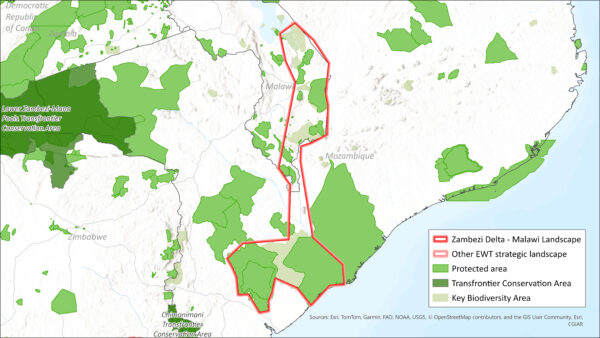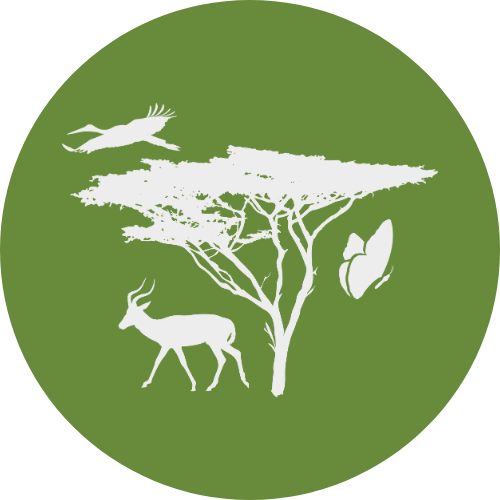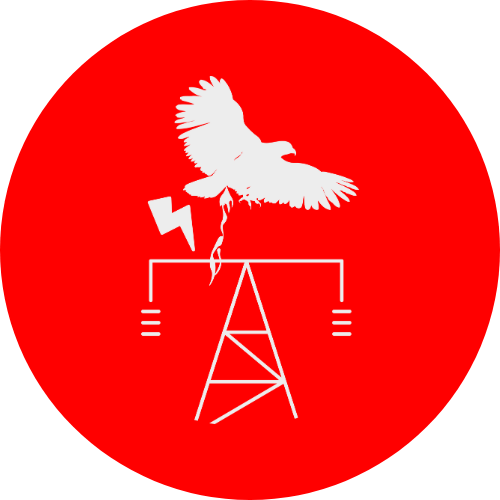ZAMBEZI DELTA TO MALAWI STRATEGIC CONSERVATION LANDSCAPE
 From the floodplains of the Zambezi Delta to the forests of southern Malawi, this corridor connects some of the most ecologically important and under-protected habitats in the region. It supports large-scale wildlife movements, rich wetlands, and species found nowhere else, such as Chapman’s Pygmy Chameleon and several endemic amphibians. Gorongosa National Park, the Marromeu wetlands, and forested mountain blocks, like Mount Mulanje, provide anchor points for restoration, while linking fragmented ecosystems across borders.
From the floodplains of the Zambezi Delta to the forests of southern Malawi, this corridor connects some of the most ecologically important and under-protected habitats in the region. It supports large-scale wildlife movements, rich wetlands, and species found nowhere else, such as Chapman’s Pygmy Chameleon and several endemic amphibians. Gorongosa National Park, the Marromeu wetlands, and forested mountain blocks, like Mount Mulanje, provide anchor points for restoration, while linking fragmented ecosystems across borders.
The EWTs work in this landscape is focused on rebuilding ecological connections and strengthening community-led conservation. We work with partners to restore degraded habitats; support threatened species like African Wild Dogs and Wattled Cranes and ensure that people who rely on these ecosystems are part of shaping their future. Many communities in the corridor depend on wetlands and forests for water, farming, and resilience in the face of climate change. Through our efforts we aim to protect these resources while building sustainable, nature-linked livelihoods.
We are developing finance tools to help fund long-term restoration and supporting local enterprise models that align economic opportunity with biodiversity goals. Where development expands, we work to ensure that infrastructure planning considers the movement of wildlife and the protection of key habitats. Scientific tools like Bioblitzes are helping to uncover new species and inform where action is most needed.
This is a landscape of recovery and reconnection, where ecological integrity, community well-being, and long-term resilience are being restored together across a living, shared landscape.
Why it’s important
This corridor connects key ecosystems, ensuring genetic flow and ecosystem services. Its wetlands sustain migratory birds, aquatic species, and surrounding communities.
Gorongosa and Malawi’s forests serve as migration routes for species like African Wild Dogs and elephants. Destruction threatens critical processes, like water filtration and flood regulation, and isolates species, pushing them toward extinction.
Protecting this ecological bridge safeguards biodiversity, supports livelihoods, and counters climate stressors, preserving essential resources for both wildlife and human communities.
So What?
Fragmentation breaks up vital ecosystems, leading to biodiversity loss and depletion of natural resources. Species like the Wattled Crane become trapped in smaller, disconnected habitats, making it harder for them to survive and thrive.
At the same time, communities that rely on healthy wetlands for fishing, farming, and tourism face growing economic hardships. Without urgent action, climate change will worsen these threats, further damaging ecosystems and livelihoods.
Protecting this corridor is essential to safeguard Africa’s natural heritage, strengthen resilience, and secure a sustainable future for both people and wildlife.
Vision
A connected conservation landscape where ecosystems thrive, biodiversity flourishes, and local communities benefit from sustainable tourism, eco-friendly livelihoods, and harmonious coexistence with wildlife.
Target Species
Landscape Size
48,967 KM²
Why we do it

protect biodiveristy
Lead collaborative efforts to safeguard species and rebuild life-sustaining ecosystems, working with, for example, governments, landowners, and Indigenous Peoples and Local Communities (IPLCs).

secure vital ecosystem services
Healthy ecosystems provide essential services like clean air, water, and food security.

Empower communities
Enable IPLCs to thrive through nature-based solutions that connect conservation with human well-being, equity, and sustainable livelihoods.

build a sustainable future
Embed biodiversity into corporate strategies and operations to deliver measurable positive outcomes for nature and create resilient, future-fit businesses.

Improve climate Resilience
Build climate adaptation and resilience into conservation efforts to protect biodiversity and human well-being.

Enhance water security
Prioritise the safeguarding of critical freshwater systems and catchments across Africa's threatened landscapes.
Cross cutting approaches

People in conservation unit
Co-developing and implementing conservation management approaches to ensure sustainable conservation impact and benefit sharing.

Wildlife and Infrastructure unit
Reducing infrastructure impacts on species and habitats.

Biodiversity and Business Unit
Supporting the integration of biodiversity into corporate strategy and operations, to achieve measurable positive biodiversity outcomes.

Sustainable Finance Unit
Focusing on mobilising financial resources to support conservation efforts.

Wildlife in Trade Unit
Disrupting and preventing illegal wildlife trade in the landscape.

Conservation Tools and Technology Unit
Discovering new species and understanding species distributions to inform conservation priorities in the landscape.
